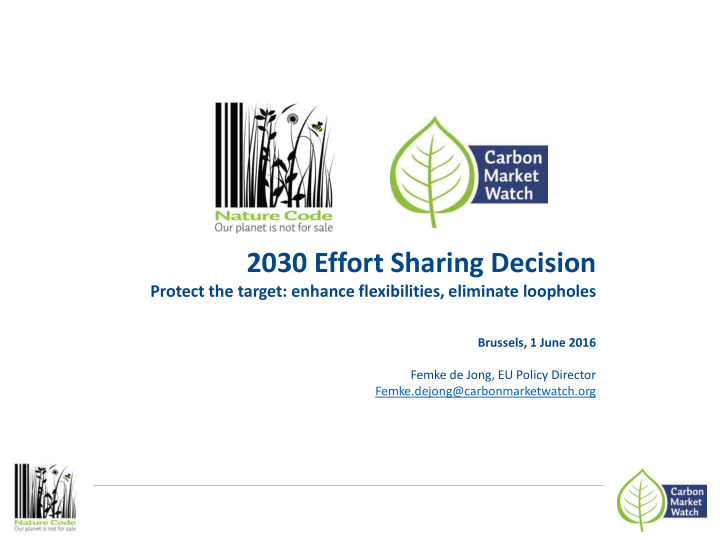



2030 Effort Sharing Decision Protect the target: enhance flexibilities, eliminate loopholes Brussels, 1 June 2016 Femke de Jong, EU Policy Director Femke.dejong@carbonmarketwatch.org
The need for more ambition in the EU’s largest clim limate in instrument The Effort Sharing Decision (ESD) covers around 60% of Europe’s greenhouse gas emissions from the surface transport, agriculture, waste and buildings sectors. EU leaders suggested in 2014 to set the ESD’s emission reduction target to 30% below 2005 levels by 2030. In light of the Paris agreement, and the transformation the European economy needs to undergo, this proposed target is not ambitious enough. The 2030 ESDS needs to be in line with an overall emission reduction target of at least 95% by 2050, supported by, at minimum a 45% reduction in ESD sectors by 2030. Both objectives should be based on an EU carbon budget to stay well below 2°C and to pursue 1.5°C.
The Effort Sharing Decis ision se sets EU and nati tional l carbon budgets The Effort Sharing Decision sets each Member State a maximum amount of greenhouse gases they can emit each year. The sum of each Member State annual budgets equals the total EU emissions budget for the period. Under the proposed target of -30% by 2030, the EU’s emissions need to be cut by a total of 2.4 billion tonnes of CO 2 -eq in the 2021-2030 period *. Projected 2020 emissions *The difference between projected 2020 emissions and the proposed carbon budgets in the 2021-2030 period (Oeko-institute, 2016)
Protect th the target: enhance fle flexibil ilities, elim liminate lo loopholes Under the Effort Sharing Decision, Member States are allowed to make use of flexibility mechanisms to make it less expensive to meet their annual emission targets. These flexibility mechanisms become loopholes when they undermine the efforts that Member States have to take to cut emissions. Under the -30% target, the 2030 Effort Sharing Decision could result emission cuts equal to 2.4 billion tonnes of CO 2 -eq. Even this (inadequate) target is at risk of being undermined by governments + stakeholders that are trying to introduce loopholes in order to minimize their contribution to cutting emissions.
Elim liminate lo loopholes to avoid emit ittin ing 4.7 .7 billi illion tonnes more CO 2 th than th the Paris clim limate ple ledge The possible loopholes include: 1. Land use offsets 2. Emissions from inflated carbon budgets 3. Surplus ETS allowances 4. Carry- over of ‘hot air’ from the current period to the next
Land use se offsets could le lead to addit itional emis issions equal to 1.3 .35 billi illion tonnes of f CO 2 in in th the ESD Source: T&E (2016)
Infl flated carbon budget could le lead to 0.7 .75 billi illion tonnes of f extr xtra CO 2 emis issions 2020 ESD 750 million extra emissions reduction with starting point at inflated target (-10%) 2020 target Actual 2021 emission levels in ESD sectors 2030 ESD reduction target (-30%) Note: Surplus from current trading period is not included in this budget. Current legislation does not allow for carry over. 2021 2022 2023 2024 2025 2026 2027 2028 2029 2030 Source: CAN-E (2016)
The use se of f ETS poll llution perm rmits could ld le lead to th the additional rele lease of f 0.3 .3 billi illion tonnes of f CO 2
The carry ry- over of ‘hot air’ to the next period could le lead to emit itting an extr xtra 2.2 .25 billi illion tonnes of f CO 2 ESD I (2013-2020 period) • Surplus of unused ESD carbon permits could add up to over 1.5 billion tonnes of CO 2 by 2020 • Additionally, Member States can use, in total, the equivalent of 0.75 billion tonnes of CO 2 ESD II (2021-2030 period) Carry-over not currently allowed
If If all ll lo loopholes are all llowed, , th the EU would ld not t have to cut t emis issions, but t could ld in increase th them The EU is at risk of emitting 4.7 billion tonnes more CO 2 -eq than its 2030 climate pledge. Rather than cutting emissions by 2.4 billion tonnes of CO 2 -eq, the EU would be allowed to increase emissions by 2.3 billion tonnes. [CO 2 emission increases] [CO 2 emission reductions]
Recommendations to deliv liver th the 2030 cl clim imate target in in reality – elim limin inate th the lo loopholes Address land and forest carbon removals separately from man-made emissions. Start counting from real emission levels, or at the 2020 target level if the latter is lower, as almost all Member States will overshoot their 2020 emission reduction goals. Ensure that the oversupply of ETS pollution permits cannot be used to undermine emission reduction efforts under the Effort Sharing Decision. Do not carry-over surplus ESD pollution permits.
Read more: Policy briefing by WWF, T&E and Loopholes infographic here Carbon Market Watch: Infographic 2-page briefing here “ The Effort Sharing Decision after 2020 ”
Recommend
More recommend